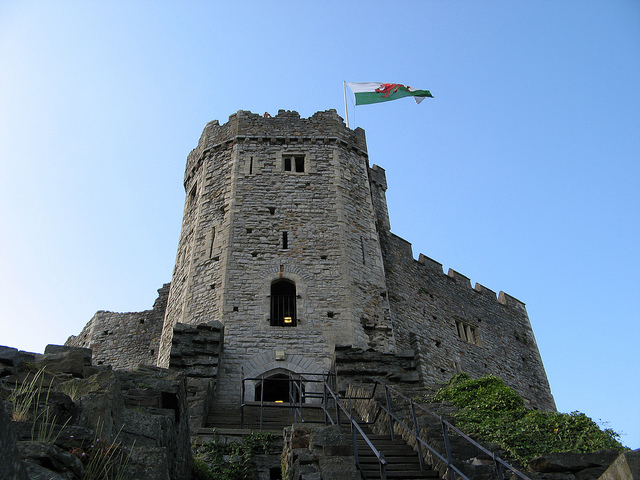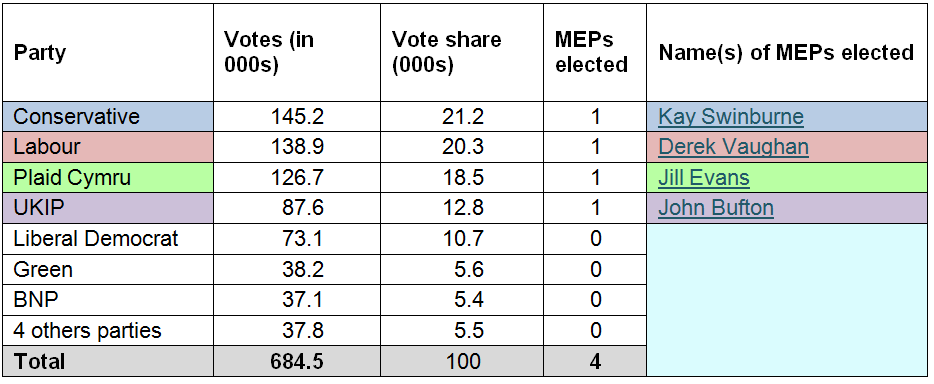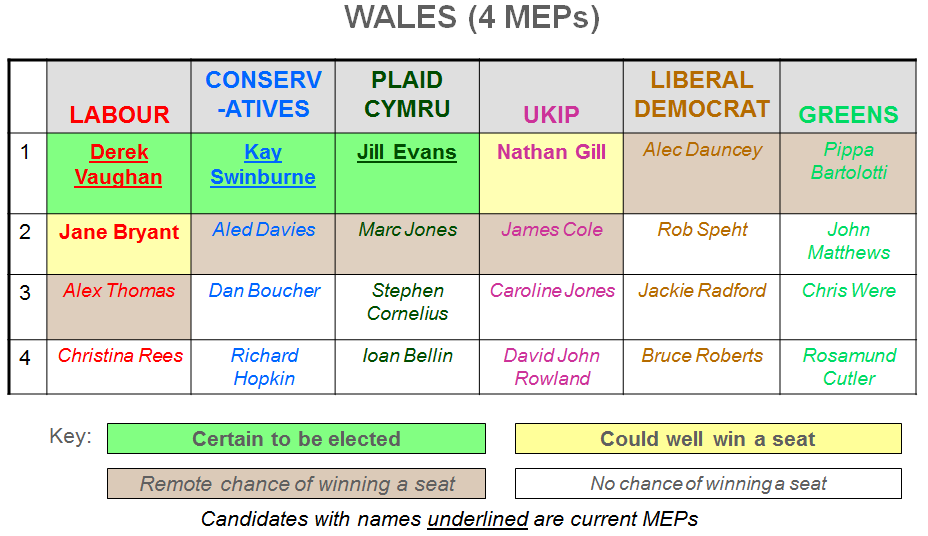Euro elections – the contest in Wales
Wales returns four MEPs and in their latest preview of this week’s Euro elections the Democratic Audit team show that Labour and the Conservatives can be pretty sure of returning two of them. There is then a four way battle over the last two seats, between them, Paid Cymru and UKIP, with others parties unlikely to have a chance of a seat.
In political terms, Wales is often seen as a Labour stronghold. However in Westminster terms the party now holds only 26 out of 40 seats, plus around half of the members of the Welsh National Assembly. The Conservatives have 8 Westminster 40 seats, and 14 out of 60 Assembly members, so their rural strongholds remain resilient. The pro-independence party Plaid Cymru has three MPs, and 11 Assembly members.
What happened last time?
Since the introduction of the List PR voting system in 1999, Labour have twice finished first in Wales’ European elections, in 1999 and 2004, when they gained over 31 per cent support. The Conservatives in opposition narrowly beat Labour in 2009, although their share of the vote was actually higher in 1999, when they finished third, than last time, when they secured 21 to Labour’s 20 per cent. Table 1 below shows that Plaid Cymru came a close third in 2009, and UKIP was fourth some way behind on just under 13 per cent. These four parties each returned a single MEP, with the Liberal Democrats narrowly missing out.
Table 1: What happened in the 2009 European elections in Wales
Note: Our vote data are rounded to the nearest thousand votes. Exact 2009 results are available from UK Polling Report here. Three of the incumbent MEPs are seeking re-election, the exception being UKIP’s John Bufton, who has stepped down.
What could happen this time, in May 2014
Given their revival in national and Welsh opinion polls, Labour will be confident about their chances of reclaiming top spot. Indeed some recent polling has put them at 35-40 per cent support, which would clearly gain them two MEPs. They even have a remote chance of winning a third MEP, depending on how the rest of the votes fragment, as our simplified ballot paper below shows. The Conservatives will probably finish some way behind, but are almost certain to hold onto their current MEP. Plaid Cymru will be hoping to hold onto their vote share and their experienced MEP, although it is possible that Labour’s likely recovery will draw from their support. UKIP’s nationwide surge makes it likely that they too will retain their seat, and they are polling strongly enough to be competitive for second place in Wales, although this has not been a past region of exceptional strength for them.
Table 2: Simplified ballot paper
Given their national ratings, the Liberal Democrats can expect to poll in single figures in Wales and so stand little chance of winning a seat, for which they would need to do better than in 2009. The Green’s will be hoping to improve on their votes, but stand very little chance of winning a seat from their previous base. The BNP vote seems to have collapsed right across the country, and Wales does not seem to be an exception to the trend.
The top parties’ candidates

 Labour’s number one candidate is their incumbent MEP Derek Vaughan, who was first elected in 2009. Prior to his election, he was a trade union official and a councillor, as well as the leader of the Welsh Local Government Association. In the European Parliament he sits on the Committee on Budgets. Derek is also a member of the Delegation for relations with the People’s Republic of China. Full details about his activities in the European Parliament can be found on the authoritative profiles maintained by the independent Group Votewatch EU profile here. He is active on social media, and on Twitter is here. He looks certain for re-election. Joining him on Labour’s list at number two is Jane Bryant. She currently works for the Labour MP Paul Flynn, and has also worked for the Australian Government and for the current presiding officer of the Welsh Assembly, Rosemary Butler. Her Twitter account is here. She stands a good chance of being elected, should Labour perform strongly as opinion polls suggest. The third Labour candidate is Alex Davies, who is a councillor in Neath Port Talbot. It is unlikely to be elected as an MEP, given the strong competition.
Labour’s number one candidate is their incumbent MEP Derek Vaughan, who was first elected in 2009. Prior to his election, he was a trade union official and a councillor, as well as the leader of the Welsh Local Government Association. In the European Parliament he sits on the Committee on Budgets. Derek is also a member of the Delegation for relations with the People’s Republic of China. Full details about his activities in the European Parliament can be found on the authoritative profiles maintained by the independent Group Votewatch EU profile here. He is active on social media, and on Twitter is here. He looks certain for re-election. Joining him on Labour’s list at number two is Jane Bryant. She currently works for the Labour MP Paul Flynn, and has also worked for the Australian Government and for the current presiding officer of the Welsh Assembly, Rosemary Butler. Her Twitter account is here. She stands a good chance of being elected, should Labour perform strongly as opinion polls suggest. The third Labour candidate is Alex Davies, who is a councillor in Neath Port Talbot. It is unlikely to be elected as an MEP, given the strong competition.

 The Conservatives’ top candidate is their incumbent MEP Kay Swinburne, who was first elected as a Conservative MEP in 2009. Originally a microbiologist by profession, she holds a number of positions in the European Parliament, including as UK Conservative Spokesperson on Economic and Monetary Affairs, and her VoteWatch EU profile can be found here. She looks likely to be re-elected. Second on the Conservatives’ list is Aled Davies, who is a County Councillor in Montgomeryshire. He is on Twitter, and his profile can be found here. It is improbable that he will win a seat.
The Conservatives’ top candidate is their incumbent MEP Kay Swinburne, who was first elected as a Conservative MEP in 2009. Originally a microbiologist by profession, she holds a number of positions in the European Parliament, including as UK Conservative Spokesperson on Economic and Monetary Affairs, and her VoteWatch EU profile can be found here. She looks likely to be re-elected. Second on the Conservatives’ list is Aled Davies, who is a County Councillor in Montgomeryshire. He is on Twitter, and his profile can be found here. It is improbable that he will win a seat.

 Plaid Cymru’s first-placed candidate is again an incumbent MEP, Jill Evans, who is seeking re-election to the European Parliament for a third time, having first been elected in 1999. She has served in a number of positions, including as the party’s Chair and as the Chair of the Wales branch of the Campaign for Nuclear Disarmament. In the European Parliament she is President of the European Free Alliance (EFA) grouping of regionalist parties and greens. Full details of her activities in the European Parliament are on her Votewatch EU profile here. Her Twitter account is here. She has a good chance of being re-elected, but much will depend on how strong Plaid’s support is. The party’s number two candidate is Marc Jones, who currently serves on Wrexham Council. He is very unlikely to be elected.
Plaid Cymru’s first-placed candidate is again an incumbent MEP, Jill Evans, who is seeking re-election to the European Parliament for a third time, having first been elected in 1999. She has served in a number of positions, including as the party’s Chair and as the Chair of the Wales branch of the Campaign for Nuclear Disarmament. In the European Parliament she is President of the European Free Alliance (EFA) grouping of regionalist parties and greens. Full details of her activities in the European Parliament are on her Votewatch EU profile here. Her Twitter account is here. She has a good chance of being re-elected, but much will depend on how strong Plaid’s support is. The party’s number two candidate is Marc Jones, who currently serves on Wrexham Council. He is very unlikely to be elected.

 The top UKIP candidate is Nathan Gill,currently the party’s Membership Secretary in Wales. A businessman, he has stood at council level for the party, but never successfully. His Twitter account is here. He stands a reasonable chance of being elected in place of the incumbent UKIP MEP John Bufton, who is stepping down, but the precise balance of UKIP and Labour support will be crucial to his chances. James Cole is second on the party’s list. He is a retired serviceman, and currently Deputy Chair of the party in Wales. UKIP only just scraped a seat in 2009, so their chance of a winning second seat is remote.
The top UKIP candidate is Nathan Gill,currently the party’s Membership Secretary in Wales. A businessman, he has stood at council level for the party, but never successfully. His Twitter account is here. He stands a reasonable chance of being elected in place of the incumbent UKIP MEP John Bufton, who is stepping down, but the precise balance of UKIP and Labour support will be crucial to his chances. James Cole is second on the party’s list. He is a retired serviceman, and currently Deputy Chair of the party in Wales. UKIP only just scraped a seat in 2009, so their chance of a winning second seat is remote.
 The top Liberal Democrat candidate is Alec Dauncey. He is a professional forester and is a former councillor and Mayor of Aberystwyth. He is on Twitter here. It would be a major surprise if he were to buck the national trends enough to have any real chance of a seat this time.
The top Liberal Democrat candidate is Alec Dauncey. He is a professional forester and is a former councillor and Mayor of Aberystwyth. He is on Twitter here. It would be a major surprise if he were to buck the national trends enough to have any real chance of a seat this time.
 The Green Party’s list for the election is topped byPippa Bartolotti, who is the leader of her party’s Welsh branch. She has stood unsuccessfully in Westminster and National Assembly elections before. She is on Twitter here. Given the few seats available and past levels of support, none of the Green Party’s candidates stand much of a chance of being elected.
The Green Party’s list for the election is topped byPippa Bartolotti, who is the leader of her party’s Welsh branch. She has stood unsuccessfully in Westminster and National Assembly elections before. She is on Twitter here. Given the few seats available and past levels of support, none of the Green Party’s candidates stand much of a chance of being elected.
—-
The boundaries of the Wales European region are the same as the area covered by the Welsh National Assembly. It borders the English counties of Cheshire, Shropshire, Herefordshire, and Gloucestershire to the east. The largest urban areas are Cardiff, Swansea, Newport and then the towns of the south Wales valleys.
—
Click here to read our other European Parliament constituency briefings
Note: please read our comments policy before posting. The shortened URL for this post is: https://buff.ly/1o1nvXd








 Democratic Audit's core funding is provided by the Joseph Rowntree Charitable Trust. Additional funding is provided by the London School of Economics.
Democratic Audit's core funding is provided by the Joseph Rowntree Charitable Trust. Additional funding is provided by the London School of Economics.
Euro election – the contest in Wales https://t.co/VmpQIIgQwg
The latest of our European Parliament elections constituency briefings (for Wales) is now up online: see it here – https://t.co/IZXUvYoggb
Euro elections – previewing the the contest in Wales https://t.co/ntcHuAEOIH
Euro election – the contest in Wales https://t.co/q4y17NMz3f